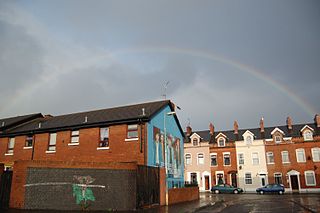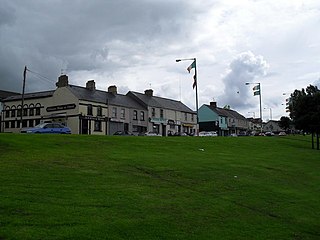
Bloody Friday is the name given to the bombings by the Provisional Irish Republican Army (IRA) in Belfast, Northern Ireland on 21 July 1972, during the Troubles. At least twenty bombs exploded in the space of eighty minutes, most within a half-hour period. Most of them were car bombs and most targeted infrastructure, especially the transport network. Nine people were killed: five civilians, two British soldiers, a Royal Ulster Constabulary (RUC) reservist, and an Ulster Defence Association (UDA) member, while 130 were injured. The IRA said it sent telephoned warnings at least thirty minutes before each explosion and said that the security forces wilfully ignored some of the warnings for their own ends. The security forces said that was not the case and said they were overstretched by the sheer number of bombs and bomb warnings, some of which were hoaxes.

The Red Hand Commando (RHC) is a small secretive Ulster loyalist paramilitary group in Northern Ireland that is closely linked to the Ulster Volunteer Force (UVF). Its aim was to combat Irish republicanism – particularly the Irish Republican Army (IRA) – and to maintain Northern Ireland's status as part of the United Kingdom. The Red Hand Commando carried out shootings and bombings, primarily targeting Catholic civilians. As well as allowing other loyalist groupings to claim attacks in their name, the organisation has also allegedly used the cover names "Red Branch Knights" and "Loyalist Retaliation and Defence Group". It is named after the Red Hand of Ulster, and is unique among loyalist paramilitaries for its use of an Irish language motto, Lámh Dearg Abú, meaning 'red hand to victory'.

The Red Hand Defenders (RHD) is an Ulster loyalist paramilitary group in Northern Ireland. It was formed in 1998 by loyalists who opposed the Belfast Agreement and the loyalist ceasefires. Its members were drawn mostly from the Ulster Defence Association (UDA) and Loyalist Volunteer Force (LVF). The name had first been used by Red Hand Commandos dissident Frankie Curry in 1996 and he was the leading figure in what was a somewhat unstructured organization until he was killed in 1999. It is named after the Red Hand of Ulster.

Ulster loyalism is a strand of Ulster unionism associated with working class Ulster Protestants in Northern Ireland. Like other unionists, loyalists support the continued existence of Northern Ireland within the United Kingdom, and oppose a united Ireland independent of the UK. Unlike other strands of unionism, loyalism has been described as an ethnic nationalism of Ulster Protestants and "a variation of British nationalism". Loyalists are often said to have a conditional loyalty to the British state so long as it defends their interests. They see themselves as loyal primarily to the Protestant British monarchy rather than to British governments and institutions, while Garret FitzGerald argued they are loyal to 'Ulster' over 'the Union'. A small minority of loyalists have called for an independent Ulster Protestant state, believing they cannot rely on British governments to support them. The term 'loyalism' is usually associated with paramilitarism.

The Ulster Workers' Council (UWC) strike was a general strike that took place in Northern Ireland between 15 May and 28 May 1974, during "the Troubles". The strike was called by unionists who were against the Sunningdale Agreement, which had been signed in December 1973. Specifically, the strikers opposed the sharing of political power with Irish nationalists, and the proposed role for the Republic of Ireland's government in running Northern Ireland.

The Shankill Road bombing was carried out by the Provisional Irish Republican Army (IRA) on 23 October 1993 and is one of the most well-known incidents of the Troubles in Northern Ireland. The IRA aimed to assassinate the leadership of the loyalist Ulster Defence Association (UDA), supposedly attending a meeting above Frizzell's fish shop on the Shankill Road, Belfast. Two IRA members disguised as deliverymen entered the shop carrying a bomb, which detonated prematurely. Ten people were killed: one of the IRA bombers, a UDA member and eight Protestant civilians, two of whom were children. More than fifty people were wounded. The targeted office was empty at the time of the bombing, but the IRA had allegedly realised that the tightly packed area below would inevitably cause "collateral damage" of civilian casualties and continued regardless. However, the IRA have denied this saying that they intended to evacuate the civilians before the explosion. It is alleged, and unearthed MI5 documents appear to prove, that British intelligence failed to act on a tip off about the bombing.
Sandy Row is an inner city area of south Belfast, Northern Ireland, which is predominantly Protestant working-class. In 2018, the population was estimated to be around 4,000. It is a staunchly loyalist area and heartland of the paramilitary Ulster Defence Association (UDA) and Orange Order.
This is a timeline of actions by the Ulster Defence Association (UDA), a loyalist paramilitary group formed in 1971. Most of these actions took place during the conflict known as "the Troubles" in Northern Ireland. The UDA's declared goal was to defend Loyalist areas from attack and to combat Irish republican paramilitaries. However, most of its victims were Irish Catholic civilians, who were often chosen at random.
This is a timeline of actions by the Ulster Volunteer Force (UVF), an Ulster loyalist paramilitary group since 1966. It includes actions carried out by the Red Hand Commando (RHC), a group integrated into the UVF shortly after their formation in 1972. It also includes attacks claimed by the Protestant Action Force (PAF), a covername used by the UVF. Most of these actions took place during the conflict known as "the Troubles" in Northern Ireland.

Frankie Curry was a Northern Irish loyalist who was involved with a number of paramilitary groups during his long career. A critic of the Northern Ireland peace process, Curry was killed during a loyalist feud.

Sailortown was a working-class dockland community in the docks area of Belfast, Northern Ireland. Established in the mid-19th century on partly reclaimed land, it had a mixed Protestant and Catholic population. The 1907 dock strike called by trade union leader James Larkin commenced in Sailortown before spreading throughout the city.

The Shore Road is a major arterial route and area of housing and commerce that runs through north Belfast and Newtownabbey in Northern Ireland. It forms part of the A2 road, a traffic route which links Belfast to the County Antrim coast.
The Antrim Road is a major arterial route and area of housing and commerce that runs from inner city north Belfast to Dunadry, passing through Newtownabbey and Templepatrick. It forms part of the A6 road, a traffic route which links Belfast to Derry. It passes through the New Lodge, Newington and Glengormley areas of Northern Ireland amongst others.

The Rose & Crown Bar bombing was a bomb attack carried out against a Catholic-owned pub in Belfast. The attack was carried out by the loyalist paramilitary group the Ulster Volunteer Force (UVF) just less than two weeks before the start of the Ulster Workers' Council strike of May 1974 which brought down the Sunningdale power sharing agreement and just 15 days before the UVF carried out the Dublin and Monaghan bombings which killed 34 and injured 300 people, the highest casualty rate in a single day during The Troubles in either Ireland or Britain.
The Avenue Bar shooting occurred on 15 May 1988 as the Ulster Volunteer Force launched a gun attack on the Avenue Bar on Union Street in the city centre of Belfast, Northern Ireland, killing three Catholic civilians and wounding six others. The bar was close to the Unity Flats complex and as a result was frequented mostly by Catholics.
On 14 November 1992, the Ulster Defence Association (UDA), a loyalist paramilitary group, launched an attack on James Murray's bookmakers on the Oldpark Road in Belfast, Northern Ireland. A gunman fired on the customers with an assault rifle, while another threw a grenade inside. Three civilians were killed and thirteen wounded. The shop was in a Catholic and Irish nationalist area, and all of the victims were local Catholics. The attack was likened to the Sean Graham bookmakers' shooting carried out by the UDA earlier that year.

The New Lodge Six shooting took place in the late hours of 3 February and the early hours of 4 February 1973, six men, all of whom were Catholics, were shot and killed in the New Lodge area of north Belfast:

The Top of the Hill bar shooting, or Annie's Bar massacre, was a mass shooting in Derry, Northern Ireland on 20 December 1972, during the Troubles. Five civilians were killed when members of the Ulster Defence Association (UDA), a loyalist paramilitary group, opened fire on the customers in a pub frequented by Catholics.
The Stag Inn attack was a sectarian gun attack, on 30 July 1976, carried out by a group of Belfast IRA Volunteers using the cover name Republican Action Force. Four Protestants, all civilians, the youngest being 48 years old and the eldest 70, were all killed in the attack with several others being injured. Three Catholics were killed the previous day in a Loyalist bomb attack, part of a string of sectarian attacks in Northern Ireland by different paramilitary organizations.













